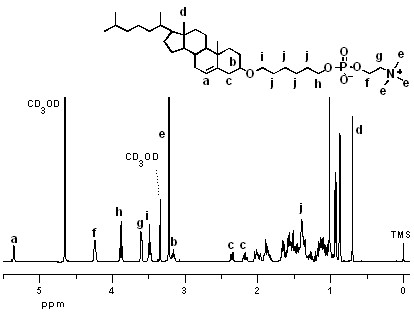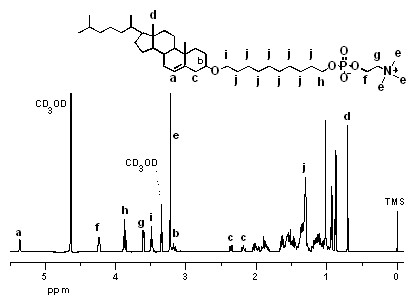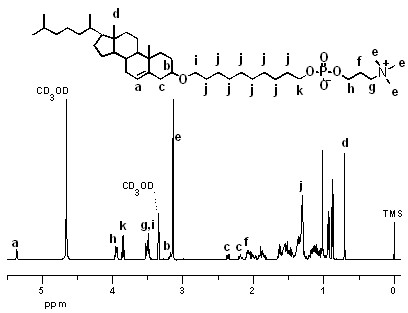Amphiphilic small molecular surfactant based on cholesterol and phosphorylcholine and preparation method thereof
A surfactant and phosphorylcholine technology, applied in chemical instruments and methods, transportation and packaging, dissolution, etc., can solve the problems of high cytotoxicity, inability to be used, unfavorable use, etc., and achieve simple preparation process, easy acquisition, easy-to-handle effects
- Summary
- Abstract
- Description
- Claims
- Application Information
AI Technical Summary
Problems solved by technology
Method used
Image
Examples
preparation example Construction
[0044] The preparation method of the amphiphilic small molecule surfactant based on cholesterol and phosphorylcholine comprises the following steps:
[0045] 1) Add 1mol cholesterol to 1mL~5×10 4 In a mixed solvent of methylene chloride and pyridine, the volume ratio of methylene chloride and pyridine is 100 / 1 to 1 / 100, 1 to 20 mol of p-toluenesulfonyl chloride is added, and 0.01 mol to 1 mol of 4-dimethylaminopyridine is added as a catalyst, Stir the reaction at 0°C to 100°C for 0.5h to 100h, remove the solvent by vacuum distillation, and recrystallize the obtained solid twice in acetone to obtain cholesterol p-toluenesulfonate. The reaction formula is:
[0046]
[0047] 2) Dissolve 1mol cholesterol p-toluenesulfonate in 1mL~6×10 4 To mL dioxane, add 1mol~50mol aliphatic straight-chain double-terminated diol, under the protection of argon or nitrogen, react at 50℃~200℃ for 4h~100h, remove the solvent by vacuum distillation, add 1mL ~6×10 4 mL dichloromethane, followed b...
Embodiment 1
[0063] Example 1: The product molecule obtained in this example has the following structure
[0064]
[0065] m=6, n=2
[0066] 1) Add 100g of cholesterol to a mixed solvent of 500mL of dichloromethane and 500mL of pyridine, then add 117g of p-toluenesulfonyl chloride, and then add 4.3g of 4-dimethylaminopyridine as a catalyst, and stir the solution at 25°C for 72 hour, the solvent was removed by vacuum distillation, and the resulting solid was recrystallized twice in acetone to obtain cholesterol p-toluenesulfonate, whose reaction formula is:
[0067]
[0068] 2) Dissolve 21.63g of cholesterol p-toluenesulfonate in 300mL of dioxane, then add 23.63g of 1,6-hexanediol, make the reaction solution under the protection of argon or nitrogen, and react at 120°C for 72 hours, the solvent was distilled off in vacuo, and 200 mL of dichloromethane was added to dissolve the resulting solid, followed by saturated NaHCO 3 aqueous solution and saturated brine for 2 washes respective...
Embodiment 2
[0078] Embodiment 2: The product molecule that this embodiment obtains is following structure
[0079]
[0080] m=10, n=2
[0081] Step 1) is identical with step 1) in embodiment 1;
[0082] 2) 26g of cholesterol p-toluenesulfonate was dissolved in 300mL of dioxane, then 36g of 1,10-decanediol was added, and the reaction solution was reacted at 120°C for 72 hours under the protection of argon or nitrogen, The solvent was then vacuum distilled off, 200 mL of dichloromethane was added to dissolve the resulting solid, and saturated NaHCO 3 aqueous solution and saturated brine for 3 times respectively, and then anhydrous Na was added to the dichloromethane solution 2 SO 4 Remove water, remove the dichloromethane solvent by rotary evaporation, and use silica gel column chromatography to separate and purify the obtained solid. The developing solvent is a mixed solvent of dichloromethane / ethyl acetate, and the volume ratio is 15 / 1. In addition to obtaining a white solid, its r...
PUM
 Login to View More
Login to View More Abstract
Description
Claims
Application Information
 Login to View More
Login to View More - R&D
- Intellectual Property
- Life Sciences
- Materials
- Tech Scout
- Unparalleled Data Quality
- Higher Quality Content
- 60% Fewer Hallucinations
Browse by: Latest US Patents, China's latest patents, Technical Efficacy Thesaurus, Application Domain, Technology Topic, Popular Technical Reports.
© 2025 PatSnap. All rights reserved.Legal|Privacy policy|Modern Slavery Act Transparency Statement|Sitemap|About US| Contact US: help@patsnap.com



